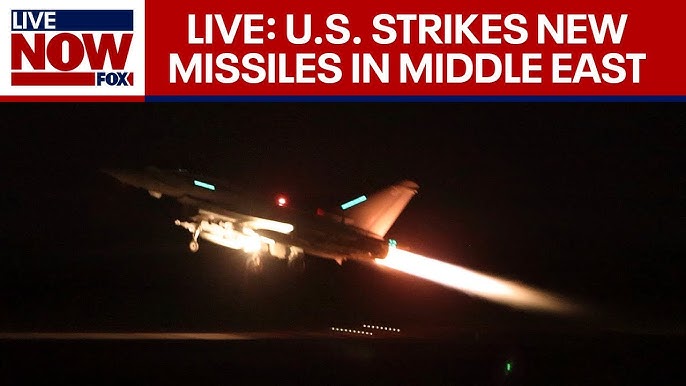BEIJING, Feb. 6 (Xinhua) — The United States and Britain Saturday night launched joint airstrikes on Houthi militia targets in Yemen, the third time in two weeks.
Just the day before, the U.S. military also carried out airstrikes on over 85 targets in Iraq and Syria related to Iran’s Islamic Revolutionary Guards Corps (IRGC) and affiliated militia groups in retaliation for a drone strike that killed three U.S. soldiers in Jordan on Jan. 28.
WHY SO MANY U.S. STRIKES?
Since the outbreak of the latest Israel-Palestine conflict, Houthi militias, demonstrating their support for Palestine, have frequently attacked Israeli vessels in the Red Sea, one of the world’s most important shipping lanes.
On Jan. 26, the Houthi armed group claimed it had launched a missile attack on a British oil tanker in the Gulf of Aden, setting it on fire, and fired one anti-ship ballistic missile toward the U.S. destroyer USS Carney in the Gulf of Aden, leading to subsequent retaliation from the United States and Britain.
Frequent attacks on ships in the Red Sea have led several international shipping companies to announce the temporary suspension of this route, opting to navigate around the southern tip of Africa. This could lead to delays and additional costs, thereby increasing shipping expenses.
On Jan. 28, a U.S. military base near the northeastern Jordanian border with Syria was attacked, resulting in the death of three U.S. soldiers and over 40 people injured. This marks the first time since the current Israel-Palestine conflict erupted that the U.S. military has reported soldiers being killed.
The United States attributes the attack to the pro-Iran group “The Islamic Resistance in Iraq,” which uses Iranian-manufactured drones to target the U.S. military in Jordan. Recently, U.S. President Joe Biden and several senior U.S. government officials have repeatedly warned of phased retaliatory measures against armed groups attacking U.S. forces, starting from airstrikes on over 85 targets in Iraq and Syria on Friday.
John Kirby, the National Security Council’s coordinator for strategic communications, said that the U.S. airstrikes on military targets in Iraq and Syria, which lasted about 30 minutes, “were carefully selected and based on clear, irrefutable evidence that they were connected to attacks on U.S. personnel in the region.”
Douglas Sims II, the director of the Joint Staff, said that the U.S. military was confident that it had hit targets that were associated with continued attacks against Americans.
WILL IT ESCALATE?
Analysts suggest that the U.S. military may continue to expand the scope of retaliation in the coming days, but a direct conflict between the United States and Iran is unlikely.
In a statement issued on Friday, Biden said that “the United States does not seek conflict in the Middle East or anywhere else in the world, but let all those who might seek to do us harm know this: If you harm an American, we will respond.”
For potential U.S. military actions against Iran, Kirby declined to reveal any specific plans when asked. However, he emphasized that the U.S. goal is “to degrade and disrupt the capabilities of the IRGC and the groups that they sponsor and support.”
Since the death of U.S. soldiers in the Jordanian attack, Biden has faced significant pressure to retaliate against Iran. Some Republicans have called for strikes on Iranian targets, but this could potentially escalate into a full-scale war, a scenario Biden wishes to avoid.
Professor Ding Long of Shanghai International Studies University believes that the U.S. policy may not be effective, and a protracted tug-of-war will likely continue in the Middle East. Ding further believes the situation is expected to remain volatile, but that a direct conflict between the United States and Iran is unlikely.
WHAT IS THE PURPOSE BEHIND IT?
Analysts argue that such chaos reflects the confusion, contradictions, and divisions within U.S. Middle East policy. This approach not only fails to bring an end to the current Israel-Palestine conflict but also exacerbates tensions in the region.
Tarek Fahmy, professor of political science at Cairo University, said that while the U.S. government seeks a ceasefire in Gaza, it continues to launch attacks on Houthi militias and targets in Iraq and Syria which indicates confusion in U.S. Middle East policy. Not only does it weaken the United States’ credibility in the Middle East, but also demonstrates its inability to address the current challenges in the region.
Regarding U.S. Secretary of State Antony Blinken’s fifth visit to the Middle East, the United States is adopting a posture of mediating a ceasefire to appease allies and ease anti-American sentiments in Arab countries, said Liu Xinlu, dean of the School of Arabic Studies at Beijing Foreign Studies University.
Bassam Salhi, general secretary of the Palestinian People’s Party, also believes that the United States has never seriously considered a ceasefire in the conflict, Blinken’s frequent visits to the Middle East are simply to prevent Biden from losing votes due to the humanitarian crisis resulting from the Gaza conflict during his reelection campaign.
Mohammed Omari, a Syrian expert on international relations, believes that the United States’ aggressive actions in an already tense Middle East exacerbate the situation, pushing the region into a highly unstable state, adding that a confrontation is imminent, and any miscalculation could push the region to the brink of conflict.
To resolve the challenges and crises in the Middle East, it is necessary to address the root cause of the current turmoil — the Israel-Palestine conflict. Achieving a permanent ceasefire in the conflict is the first step to solving the dilemma, said Ding.

